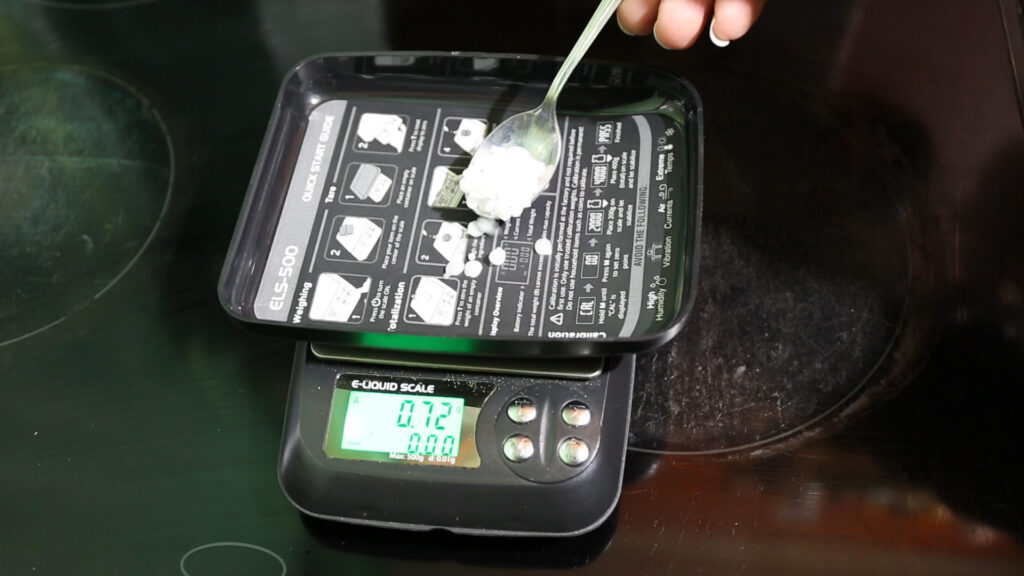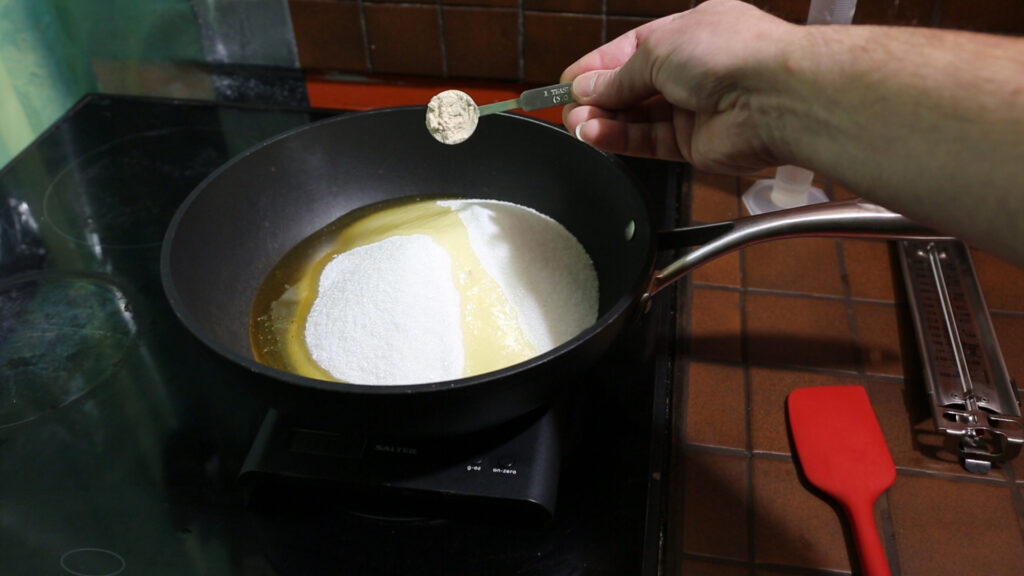How to make Belgian Candi Sugar. (And also how to make Belgian Candi Syrup, we just add some water for storage.)
I’ll preempt this by saying that this is not going to taste exactly the same as say, D-180, as the manufacturers guard their production process of how to make belgian candi sugar quite closely. However, in the finished brewed product, it’s very close, and in fact I’ll go so far as to say that this version actually has more depth of flavours than most of the commercial rock-candi products. I personally think it has more flavour than D-90 or D-180.
To arrive at this method, I had to do a lot of research, along with much trial and error. I’m not going to pretend, however, that this is all my own work. The basis of what I’m going to list below is largely from information picked up from various sites across the internet, and then adapted to work for me flawlessly every time.
What you’ll need
I’m going to assume we’re making 1 kg of sugar, so you can adjust quantities up and down to scale for your batch size. We need:
900 grams White Sugar
0.8 grams Lye (food grade)
150 grams Honey
5 grams Dried Malt Extract (or liquid malt, but upscale a little for the water content)
200 ml Water
Silicon trays, or parchment paper
1 Wok, yes that’s right, a wok (preferably large)
So, let’s get started……..

Measure out approximately 20ml of luke warm water(accuracy with water here is not crucial, but too much will over cool the sugar later on)
Add the 0.8 grams of food grade Lye, and dissolve.
Put this aside for later on. Be careful with this, it’s highly caustic and can cause burns.

Pour the sugar into the wok with the dried malt extract and honey.


Now add the 200ml of plain water (NOT the Lye water) and stir together. We’re trying to mix the DME and dissolve it as best we can, as I find this can sit in lumps and not melt with the sugar as we heat it up.
Now, turn the heat on. Heat this up slowly, and stir to dissolve the sugar. This is not spun sugar, it will not crystalise, stir away whenever you feel it needs it..
The reason we add the honey is to provide inverted sugars, ie glucose and fructose. Honey is 40% Fructose and 30% Glucose. It is these invert sugars that that going to undergo maillard reactions with the proteins from the DME. These will happen in an alkaline environment, which is why we require the Lye water later on.
So… because there is invert sugar already present, the sugar will not crystalise.

As the mixture heats up and starts to boil, keep the heat fairly low. There is still all the water present, and it will start to boil off at 100°c. If the heat is to high here, the syrup will boil up into a frothy mess, and regardless of how big the wok is, it will boil over. Just be patient, and let the water boil off.
I don’t bother to put a thermometer in until the syrup is clear and boiling. As it’s full of water, it won’t be hotter than about 110 -115°c, and you won’t get the temperature over 120°c until almost all the water has evaporated.
Now I’ll put the thermometer in.

There is a bit of parallax error on the thermometer, and it’s about 3 -4°c lower than it looks.
By the time we are at 125°c, the majority of the water has evaporated. If we didn’t have honey in the ingredients, this is the temperature we would hold the syrup for about 30 minutes. That would invert a proportion of the sugar, and provide the glucose and fructose. This is the other reason i use honey. It saves half an hour of time, and of course heat energy.
You can see below, how much volume it’s starting to take up, and why I suggest a large wok. The wok allows the bubbles to dissipate, and settle back through the syrup to be reheated. The walls of the wok heat up, which doesn’t seem to happen when using a pot, so the the syrup continues to heat as it comes up the sides, and as you’ll see, at the higher temperatures the bubbles will come from the sides, and settle into the middle. This will help control the bubbling, and doesn’t tend to boil over the sides (unlike my experiences using pots).

Now, gently take the temperature up to about 140°c. At this temperature we add the Lye water. DO THIS SLOWLY. The sugar is going to bubble and spit as we pour this in, so pour small amounts at a time. As can be seen in the picture below, the colour will change straight away, and will start to go dark yellow, then red and brown. This is the maillard reactions occurring. We are now forming the melanoidins that give our sugar the dark fruit flavours. If fruit flavours are what you’re after, then hold it at 140-145° until you achieve the flavour and colour profile you want.

I’ll take colour samples as we go, as you can see below, straight after adding the Lye, we have a deep golden colour.

I’m not pausing at 140 to 145°, I’ve kept the heat on and am just passing through this temperature, so the next picture shows the colour as we pass through 160° c.

For this batch, I’m not after so much fruit flavour, (although there is already some there), I’m going straight for dark chocolate, coffee and roasted flavours. So, keeping the heat on, this next picture is as we hold at 165°c. If this is your first attempt at this sugar, I would probably stop here.
If, however, you’ve made candi sugar before, you’re after deep roasted type flavours, and most importantly, you have good temperature control at this stage. Then continue on.

We’re now going to take the temperature up to 170°c. This is where the dark roasted coffee flavours develop. At these temperatures we are also caramelising the sucrose as well, so the resultant beer will get strong caramel tones to it.
As I said previously, you need good temperature control for this. It’s easy to get too hot, and the sucrose will burn over about 177- 179°c. The sugar has no astringent burnt taste at this point, but over 177 degrees, it will develop very bitter burnt flavours. You will not want that in your beer.

I’m going to push this right to the limit here, and take it up to 175°c.
You can see in the below picture how dark this is getting. The flavour being developed at this temperature is akin to roasted barley. Sort of burnt, but not burnt if you know what I mean. It complements sweet beer with roasted barley very well. Beers such as foreign export stout or tropical stout for example.

If you try this yourself, DO NOT sit at this temperature for long. I’ve merely hit 175°c briefly, and then removed it from the heat. The difference you can see between the sample taken above and the sample taken below, is a significant colour change. That was probably on that temperature for less than a minute.

Below, are two pictures of the sample plate. The last two samples look very similar, but the second picture is back-lit, which shows there is a significant colour change… and that happens very quickly.

Below is the back-lit sample plate for more clarity.
So for reference:
1st: 140°c 2nd: 160°c 3rd: 165°c 4th: 170°c 5th: 175°c 6th: 175°c after less than a minute.

Whilst the sugar is still hot and liquid, pour it into the silicon trays, or into a parchment lined tray.

Once the sugar is cool and hard, remove it from the trays. I like to keep mine in a zip lock bag, coated in a dusting of icing sugar to stop the pieces sticking together.
It’s possible to carefully add a small amount of water to the heated mixture, to end up with syrup. I find the hard candi easier, as I get an accurate measure of exactly the right weight of sugar, so that my gravity measurements are spot on for beer making. But you can decide on your own storage to suit yourself.

I hope you’ve enjoyed this article on how to make belgian candi sugar, and if you want to see the full process, take a look at the video on YouTube.
Click here for the video – How to make Belgian Candi Sugar
For some recipe ideas to use this ingredient, try this Dark Lager or some Spiced Cider
If you give it a shot yourself, I’d love to hear how it went. Leave a comment below or on our YouTube page. Enjoy brewing folks.
Hi,
Whenever i try this adjunct and taste it, i just get only burnt sugar taste even i didn’t let it raise above 145 C…i am afraid it affect the taste of the beer, is that normal?
I taste the sugar/strup not getting any fruit whatsoever
What do you suggest?
Thank you
Thanks for reaching out and letting me know.
I’ve had great success with this method over the years, and I tend not to change how I do it, however, that doesn’t necessarily mean that someone with a different stove, a different pot/wok and perhaps a different honey, won’t get a different result.
I have had a lengthy discussion with one of my viewers in the comments on my YouTube video for this. (It would be worth reading these, if you haven’t already) He was having trouble initially with burning the sugar as well, even at low temperature.
One of the reasons was that he was making a smaller batch, and the temperature was hard to both measure and control at that volume. So if you are making a small size batch, then this could be one reason.
In the end, he also had more success by using golden syrup. This is a copy of one of his comments:
“600 grams of sugar and 500 grams of golden syrup +1.2 grams of lye was much better, no crystallization and much finer boiling. 30 min at 140 and 30 min at 160. D90/180 has a sour taste, got something similar this time. More fruity than other attempts.”
As I say, it could be a number of factors, but as with the above viewer, adjusting some parts might make a difference.
If you have more questions, please ask….